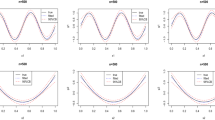Abstract
In this article, we propose a new method for analyzing longitudinal data which contain responses that are missing at random. This method consists in solving the generalized estimating equation (GEE) of [8] in which the incomplete responses are replaced by values adjusted using the inverse probability weights proposed in [17]. We show that the root estimator is consistent and asymptotically normal, essentially under the some conditions on the marginal distribution and the surrogate correlation matrix as those presented in [15] in the case of complete data, and under minimal assumptions on the missingness probabilities. This method is applied to a real-life data set taken from [13], which examines the incidence of respiratory disease in a sample of 250 pre-school age Indonesian children which were examined every 3 months for 18 months, using as covariates the age, gender, and vitamin A deficiency.
Similar content being viewed by others
References
R. M. Balan and I. Schiopu-Kratina, “Asymptotic Results with Generalized Estimating Equations for Longitudinal Data”, Ann. Statist. 33, 522–541 (2005).
P. Billingsley, Probability and Measure, 3rd ed. (Wiley, New York, 1995).
K. Chen, I. Hu, and Z. Ying, “Strong Consistency of Maximum Quasi-Likelihood Estimators in Generalized Linear Models with Fixed and Adaptive Designs”, Ann. Statist. 27, 1155–1163 (1999).
B. Chen, G. Y. Yi, and R. Y. Cook, “Weighted Generalized Estimating Functions for Longitudinal Response and Covariate Data That are Missing at Random”, J. Amer. Statist. Soc. 105, 336–353 (2010).
P. J. Diggle, K.-Y. Liang, and S. L. Zeger, Analysis of Longitudinal Data (Clarendon Press, Oxford, 1996).
G. M. Fitzmaurice, S. R. Lipsitz, G. Molenberghs, and J. G. Ibrahim, “Bias in Estimating Association Parameters for Longitudinal Binary Responses with Drop-Outs”, Biometrics 57, 15–21 (2001).
N. J. Horton and N. M. Laird, “Maximum Likelihood Analysis of Generalized Linear Models with Missing Covariates”, Statist. Methods Medical Research 8, 37–50 (1998).
K.-Y. Liang and S. L. Zeger, “Longitudinal Data Analysis Using Generalized Linear Models”, Biometrika 73, 13–22 (1986).
P. McCullagh and J. A. Nelder, Generalized Linear Models, 2nd ed. (Chapman and Hall, Boca Raton, 1989).
J. M. Robins and A. Rotnitzky, “Semiparametric Efficiency in Multivariate Regression Models with Missing Data”, J. Amer. Statist. Assoc. 90, 122–129 (1995).
J. M. Robins, A. Rotnitzky, and L. P. Zhao, “Analysis of Semiparametric Regression Models for Repeated Outcomes in the Presence of Missinga Data”, J. Amer. Statist. Assoc. 90, 106–121 (1995).
J. R. Schott, Matrix Analysis for Statistics (John Wiley, New York, 1997).
A. Sommer, J. Katz, and I. Tarwotjo, “Increased Risk of Respiratory Disease and Diarrhea in Children with Preexisting Mild Vitamin A Deficiency”, Amer. J. Clinical Nutrition 40, 1090–1095 (1984).
C. Y. Wang, Y. Huang, E. C. Chao, and M. K. Jeffcoat, “Expected Estimating Equations for Missing Data, Measurement Error, and Misclassification, with Application to Longitudinal Nonignorable Missing Data”, Biometrics 64, 85–95 (2008).
M. Xie and Y. Yang, “Asymptotics for Generalized Estimating Equations with Large Cluster Sizes”, Ann. Statist. 31, 310–347 (2003).
G. Y. Yi, W. Liu, and L. Wu, “Simultaneous Inference and Bias Analysis for Longitudinal Data with Covariate Measurement Error and Missing Responses”, Biometrics 67, 67–75 (2011).
G. Y. Yi, Y. Ma, and R. J. Carroll, “A Functional Generalized Method of Moments Approach for Longitudinal Studies with Missing Responses and Covariate Measurement Error”, Biometrika 99, 151–165 (2012).
G. Y. Yi, X. Tan, and R. Li, “Variable Selection and Inference Procedures for Marginal Analysis of Longitudinal Data with Missing Observations and Covariate Measurement Error”, Canad. J. Statist. 43, 498–518 (2015).
K.-H. Yuan and R. I. Jennrich, “Asymptotics of Estimating Equations under Natural Conditions”, J. Multiv. Anal. 65, 245–260 (1998).
Acknowledgments
Research supported by a grant from the Natural Sciences and Engineering Research Council of Canada.
Author information
Authors and Affiliations
Corresponding authors
About this article
Cite this article
Balan, R.M., Jankovic, D. Asymptotic Theory for Longitudinal Data with Missing Responses Adjusted by Inverse Probability Weights. Math. Meth. Stat. 28, 83–103 (2019). https://doi.org/10.3103/S1066530719020017
Received:
Accepted:
Published:
Issue Date:
DOI: https://doi.org/10.3103/S1066530719020017
Keywords
- longitudinal data
- generalized estimating equations
- asymptotic properties
- missing at random
- inverse probability weights




